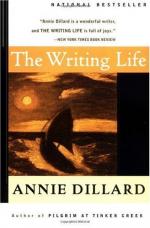
|
| Name: _________________________ | Period: ___________________ |
This test consists of 15 multiple choice questions and 5 short answer questions.
Multiple Choice Questions
1. Dillard refers to writing as changing "..from an expression of your notions to an epistemological tool." What does epistemological mean?
(a) Bacterial DNA that is extrachromosomal.
(b) Surgical incision of the perineum during childbirth.
(c) Greek knowledge.
(d) A philosophy concerned with the nature and origin of knowledge.
2. What does Dillard say that the printed word cannot compete with?
(a) Travel.
(b) The movies.
(c) People.
(d) Music.
3. Which insect is discussed in the book as part of an entomological experiment?
(a) A fly.
(b) A worm.
(c) Phataria.
(d) A butterfly.
4. Finish this West African proverb from Chapter 2: "The beginning of wisdom is.."
(a) listening to others.
(b) to get you a roof.
(c) nature.
(d) to open a book.
5. Where does Dillard say she wound up putting her pen drawing in Chapter 2?
(a) On the wall of the library.
(b) On her kitchen fridge.
(c) Taped to the venetian blinds.
(d) Between the pages of her novel.
6. How does Dillard describe the process of writing a book?
(a) "It is a dreamlike task."
(b) "It is boring and difficult."
(c) "It is something to avoid at all costs."
(d) "It is life at its most free."
7. Which author would walk through the hills for seven or eight hours on end without a hint of fatigue?
(a) Nietzsche.
(b) Stevens.
(c) Emerson.
(d) Dante.
8. What had Dillard forgotten all about as she worked on a Fourth-of-July night?
(a) The rest of the world.
(b) Eating dinner.
(c) Her books.
(d) Where she was in her writing.
9. Oftentimes, what part of Dillard's work must be edited out?
(a) The dialogue.
(b) The typos and misspellings.
(c) The best-written part.
(d) The opening paragraph.
10. What does Dillard say that she found so appealing about a Danish aristocrat?
(a) His life of leisure.
(b) His title.
(c) His ability to relax.
(d) His daily schedule.
11. Who does Dillard say that she believes to be one of the most prolific writers who has ever lived?
(a) Thomas Mann.
(b) William Shakespeare.
(c) Edgar Allen Poe.
(d) James Patterson.
12. Where does the "line of words" go at the end of Chapter 1?
(a) To the sun.
(b) To Venus.
(c) Out past Jupiter.
(d) To Houston, Texas.
13. Who did Dillard see standing at the chess table in the Roanoke library one night?
(a) The librarian's wife.
(b) The head librarian.
(c) Her phantom opponent.
(d) A baby in a diaper.
14. What did Wallace Stevens dictate to his secretary?
(a) Letters.
(b) Editorial essays.
(c) Poetry.
(d) Orders for lunch.
15. What does Dillard say that she feels a writer must do about feeling one's work in progress is either magnificent or abominable?
(a) Ignore it and not indulge in the feeling.
(b) Ask for help from readers.
(c) Get the work critiqued.
(d) Celebrate or cry.
Short Answer Questions
1. When Dillard relays a story about a cabdriver singing a boring song, why did the driver sing it twice?
2. What did Dillard do one night in the rare book room of the Virginia library?
3. What part of the body does the "line of words" in Chapter 1 invade?
4. Who is the main character in a story told by Ernest Thompson Seton?
5. Which religious sect did Dillard read about in the Virginia library?
|
This section contains 553 words (approx. 2 pages at 300 words per page) |

|




